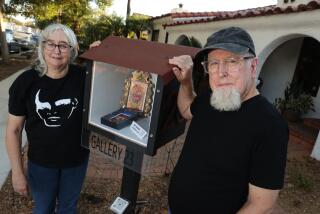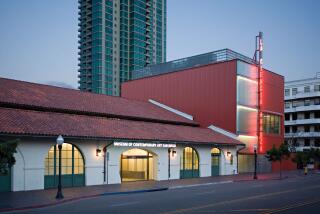ARTS BEAT : Still Another Faltering San Diego Gallery to Close
- Share via
Because of insufficient sales, the 8-year-old A.R.T./BeasleyGallery will close July 27. The commercial gallery, at 1802 Juan St., has lost money for the last two years, said John McConnell, a partner in the gallery.
It will be the fifth closing of a San Diego gallery in a year.
“It’s a very competitive business, and we weren’t making enough to make a go at it. You have to sell $300,000 to $400,000 a year,” McConnell said.
Although the gallery’s sales volume had doubled over the last two years, it was not high enough to keep the company afloat, he said.
A.R.T./Beasley represents 50 San Diego artists and about 80 other artists, primarily from the West Coast, McConnell said. From 80%-90% of the gallery’s business has been contract work with corporations or designers.
“A lot of it is fast-food art,” McConnell said. “Even on the high end, the chain galleries bring in recognizable images that are multiple images and sold at outrageous prices. The only way we could keep open was by contracts--large corporation work for law offices or accounting firms or brokerage houses. That’s bid by the floor. We might as well work out of a warehouse.”
The gallery sought to subsidize its one-person shows for emerging artists through such contracts, according to McConnell.
A.R.T./Beasley will join four others, all contemporary art galleries, that have gone out of business, citing slow sales. The closing of the Anuska, Patti Aande, Mark Quint and Natalie Bush galleries, all of which showcased emerging San Diego and Southern California artists, was a blow to the art scene.
A fine writer can a achieve a number of ends in a well-written piece. Herman Melville managed to write a fabulous sea adventure, a metaphor for life and a detailed account of 19th Century whaling practices in one book, his mighty novel, “Moby Dick.”
Playwright J.R. Gurney hasn’t done badly either in his autobiographical “The Cocktail Hour,” which closes Sunday at the Old Globe Theatre. Gurney has written a witty contemporary comedy of manners that is also an almost clinical case study of adult children of alcoholics.
Using as his plot the return of a son who asks his upper-middle-class New England parents for permission to produce a play about his father, Gurney lays bare the effects of growing up in an alcoholic environment.
We see that one son, the playwright, learned early how to get the attention that his parents withheld by using any means. We see that the other son learned to distance himself from the home life that his alcoholic parents made so unpleasant.
And the daughter strives for perfection and the impossible task of trying to hold this home together. Image is everything in this family. The daughter is the perfect wife and mother to her children, while supporting her aging parents whenever they call.
Everyone has learned to deny reality quite well. Although the daughter is dying to learn to work with guide dogs, it seems too outlandish. It doesn’t fit the image she thinks people expect in her.
The older son would love to build boats. But he works in sales, a proper job.
And then there’s the playwright’s mother, who remembers a passionate love affair she once had. That too, it turns out, was spoiled by alcoholism.
Institutions come and institutions go. But, after 20 years, it will be sad to see the San Diego Folk Festival pack up its old kit bag once and for all. Despite scores of letters addressed to City Hall that stressed the festival’s significance--letters written by musicians as diverse as Pete Seeger, David Crosby and George Winston--the City Council set aside nothing in next year’s arts budget for the event’s annual sponsor, the San Diego Friends of Old-Time Music.
Once acclaimed by the Library of Congress as “the finest traditional music event in the western United States,” this annual rite of spring has fallen on hard times. It was once eagerly embraced and funded by the San Diego State University Cultural Arts Board as a sure-fire moneymaker. The weeklong festival of concerts used to attract thousands. Dozens of yodelers, singers and fiddlers played everything from Norteno and Gospel music to blues and Yiddish klezmer music.
This year the volunteer-run festival was a mere shadow of its former musical splendor, attracting only about 300, according to Lou Curtiss, festival co-founder and annual organizer.
“It’s so hard to get any money for people’s music, Curtiss said. Although granted $799 by COMBO for 1988, the Friends of Old-Time Music received nothing in the city’s 1989 arts budget.
Indeed, the City Council financed only one of six traditional and ethnic musical groups (including jazz organizations) that applied, although it financed all 13 classical music organizations applying, with six getting fund increases.
In San Diego’s rush to be “cultural,” it seems we are overlooking our real musical heritage.
More to Read
The biggest entertainment stories
Get our big stories about Hollywood, film, television, music, arts, culture and more right in your inbox as soon as they publish.
You may occasionally receive promotional content from the Los Angeles Times.










